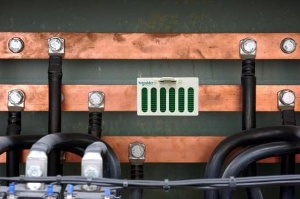Micropelt from Germany has come up with qNODE, a wireless sensor that ensures safety and power supply to production units that run 24/7.
The qNODE is born out of the collaboration between Micropelt and Schneider Electric. Components such as busways having loose ends or degraded busbars that are subjected to much wear and tear. Such parts get heated up easily and can cause a major burn out and can halt the entire production process leading to financial losses. Fabrice Hure, who heads the Installed Base Services of Schneider Electric, said that the qNODE was designed to reduce such risks for their customers.
 Qnode wireless sensor
Qnode wireless sensor
Wireless monitoring of temperature offers advantages such as lowering of cost and continuous coverage at all load conditions. They are compact in size and installation is easy in new as well as in existing units. These sensors are battery operated, hence the maintenance of batteries require complete shutdown of the unit. This factor propelled Fabrice Hure and team to work on a wireless monitoring sensor.
Micropelt took to thermal energy harvesting as this technology turns the resistive heat into electric power. The thermoelectric technology from Micropelt can generate 140 millivolts per Kelvin (K) of temperature differential. The qNODE, which is a thermo harvesting wireless sensor generates power from the resistive heat offered by the monitored device such as busbars, busways etc. The qNODE easily slips over the busbar and can be adjusted according to the dimensions of the busbar. As and when the temperature difference between the surface and the surroundings reaches 5°C, the qNODE starts power generation for transmitting the temperature of the busbar every second. Dr. Joachim Nurnus, the CTO of Micropelt regards the qNODE as the fastest and most cost- effective method to safeguard the power distribution system. Burkhard Habbe, the VP of Micropelt talked about the plans of commercializing the qNODE with vendors to match the current requirements of the market. At present qNODE makes use of the Micropelt’s simplified protocol for evaluation, based on energy demand..
Source: http://www.micropelt.com